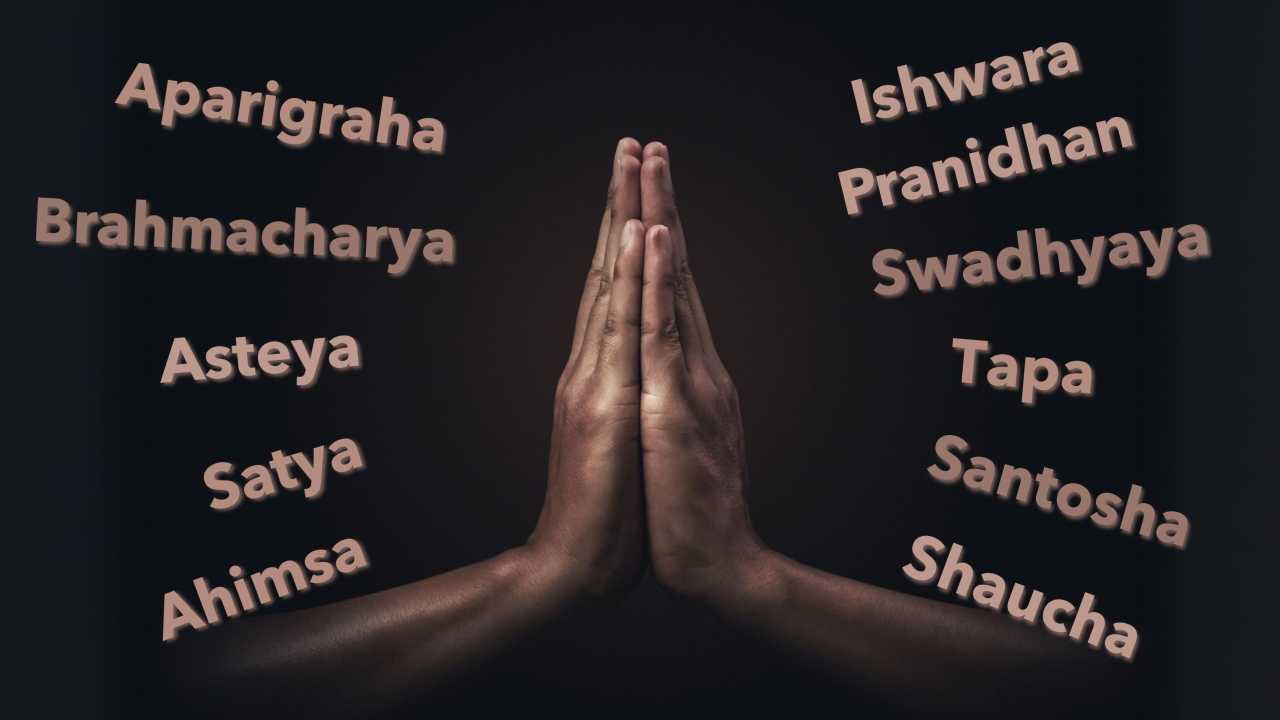
The discipline of yoga doesn’t begin—or end—with asanas. Just as a tree can bear flowers only with its roots deep in the earth, the yoga aspirant must carefully cultivate certain foundational values without which the flower of meditativeness won’t bloom. Sage Patanjali has grouped them into five yamas (restraints) and niyamas (observances), which purify the mind and prepare the ground for sadhana. In this article, revered Gurudev Anandmurti Gurumaa’s profound insights guide us through each of these ten pillars of yogic living.
Yama: The Code of Conduct
The word 'Yama' means restraint or rules. The yamas are five moral codes of conduct to follow when interacting with others. They are:
1. Ahimsa (non-violence)
2. Satya (truthfulness)
3. Asteya (non-stealing)
4. Brahmacharya (sexual restraint/channelizing energy towards liberation)
5. Aparigraha (non-hoarding)
The first is ahimsa—non-violence. Non-violence in speech, action, and thoughts; toward others as well as to oneself. When I speak, I don’t use harsh words, abuse others, or speak rudely.
Someone once asked me, “Gurumaa, I’m going to see a boy. How would I know whether he’s a fine person?” I suggested that she observe how he eats, how he talks, particularly to waiters, drivers or the poor—those who don’t have any power.
After the meeting, she came back and said, “I have rejected the boy.” I asked, “Why?” She explained, “When we settled down at the restaurant table, he called a waiter by making a sound, ‘Shh, Hey!’ For me, he'd failed right away. That’s not the way to call anyone. Just because he earns less money doesn’t mean he doesn’t deserve respect.”
And we Indians have this fallacy that we only respect rich people. We address them so politely: ‘Oh Sir, oh Ma’am!’ But if it’s a rickshaw driver or vegetable vendor, we go, “Hey, tsh tsh!” This is violence of speech—don’t do that.
Avoid violent actions, like punching another, and even violent thoughts. An employee once said to me, “I really wish to kill my boss.” I said, “Would you really do that?” He said, “No, no. I don’t want to end up in jail.” But he had the thought. And God knows how many wives had this thought once for the husband, or vice versa. When you wish to hurt or malign someone, speak ill or think badly about another, that is violence. So, practise non-violence.
Second: satya—truthfulness in speech, action, and thoughts, and to always be on the path of truth. This is mandatory; it's the very beginning of the journey. Be truthful—a habitual liar can’t become a yogi. First: moral conduct. Now, whether you are Sikh, Buddhist, Jain, or Muslim, you need to follow this code, right?
Third: asteya—practising non-stealing, not taking that which does not belong to you. Isn’t it a beautiful code? It should be adopted by everyone, everywhere. It’s not only about stealing objects. Sometimes, we commit a more subtle kind of theft. Like, you read a nice statement in a book, and then you use it in your conversation without revealing the author, behaving as if it were your own—even that is stealing. Don’t steal.
Fourth: brahmacharya. Brahmacharya at the physical level implies celibacy, whereas its deeper meaning is to be in union with Brahman (supreme consciousness). If you are married, be perfectly loyal to your spouse—don’t look here and there. If you have a restraint on your sexual conduct and practise yoga, you are called a yogi. We have a long list of yogis who were very much married and had children. To become a yoga practitioner, you don’t need to remain full-time celibate or unmarried.
The fifth yama is aparigraha—not possessing beyond what is needed. Not to hoard things, emotions, or feelings. Parigraha means to hoard, to collect—aparigraha, thus, means not hoarding. When you have a hundred sarees and yet you want to buy two more, that is parigraha. Whereas if you reason, “Well, I don’t need more than 15,” and you give it away to others, that will be aparigraha.
When you have money, it’s so easy to keep buying and accumulating stuff. These days, you don’t even have to go out; take your phone, buy it, and it’ll be delivered to your home. People have so much stuff that they run out of space, yet still keep buying. One who hoards material things cannot be a true practitioner of yoga.
Hoarding isn't limited to material things, but it also includes emotions. Someone said harsh words to you ten years ago, and you still remember it; you still want revenge. “He said this to me! How dare he?” You were powerless and couldn’t fight back, but you have stored the anger in your mind.
A 60-year-old man once pointed towards another man and told me that person had stolen his geometry box in third standard—he’s still angry with him! I said, “I think you should go and confront him, ‘You stole my box.’” He said, “No, no, it will look so stupid.” I said, “Really? If it looks stupid to speak up, doesn’t it look stupid that you are keeping it in your mind?” Even this is parigraha. Is your mind a garbage bin, storing all these negative things? If you want to be a yogi, leave it. Forgive and forget; don’t hold on to emotions.
Niyama: Self-Discipline
The five yamas apply to interactions with others, while the five niyamas are disciplines to follow within oneself. They are:
1. Shaucha (cleanliness and purity)
2. Santosha (contentment)
3. Tapa (austerity)
4. Swadhyaya (self-study)
5. Ishwara Pranidhana (surrender to God)
It begins with shaucha, cleanliness—outer cleanliness and inner purity. Inner purity means not holding grudges against others, not thinking badly or wishing ill for others. This is purity of mind.
Bathing, wearing clean clothes, living in a clean environment, and eating pure food—all this constitutes outer shaucha.
Next is santosha—contentment. Choiceless acceptance of all that is happening in one's life is called santosha. Not hankering for anything, being contented and satiated within. “I don't complain, and I accept whatever I have.” That is santosha.
The third niyama is tapa. It refers to austerity and bearing all discomforts that accompany the spiritual path, as well as complete dedication to spiritual practices. For example, waking up at 4:30 a.m. is tapasya. Most people won’t do it—unless they need to catch a flight, then they will!
Tapa means you choose to follow a discipline, even if it means sacrificing the last hours of your sleep. And you sleep on time. See, if you sleep at midnight, waking up at five will become a punishment, right? Whereas it becomes easy when you sleep by ten. Try this. If you can't try it at home, come to me in my ashram. You'll be put to bed by 9:30, because lights will be off—no entertainment, no TV—then, waking up at 4:30 will be doable.
Getting up early, eating in moderation, and bearing insults with patience are all tapasya. If somebody insults you, take it with a bowed head. You don't get agitated because someone will speak according to the quality of their mind.
If someone’s mind is bitter, their tongue will be bitter too—sweet, jalebi-like words won’t come from such a mouth, right? So, have some sympathy for those with a bitter tongue. Poor people, they never got a chance to taste anything sweet, hence they are bitter. Don't fight with them. Possibly maintain distance to those who are rude, arrogant, and proud. If you can't—because the bitter person happens to be your spouse—well, then plug your ears with cotton!
Next niyama: swadhyaya, self-learning. Reading and contemplating books on yoga and gyana is swadhyaya. And when you finally understand who you are, and focus on your real Self, that is the truest form of swadhyaya.
The fifth and last is ishwara pranidhana—it is dissolving oneself and surrendering completely to the will of the Almighty. The word ishwara (God) is found only sparsely in Patanjali's 185 sutras. Here, it appears—ishwara pranidhana means devotion to the Lord.
Don’t be someone who constantly says, ”Me, me, me.” “I'll do this, I'll do that”—no, no. Ishwara pranidhana means, “God will grace and help me, giving me the strength to learn and practice.” Don't be an egotistical person; be humble. Always remember the Lord.
Note: With all ten yamas and niyamas firmly in place, one becomes ready to advance and ascend the higher rungs of yoga, as will be explored in the next article of this series: "From Asana to Samadhi: Towards the Highest State of Yoga"
To understand the true meaning and purpose of yoga, begin with Part 1 of this series: “What is Yoga?”







